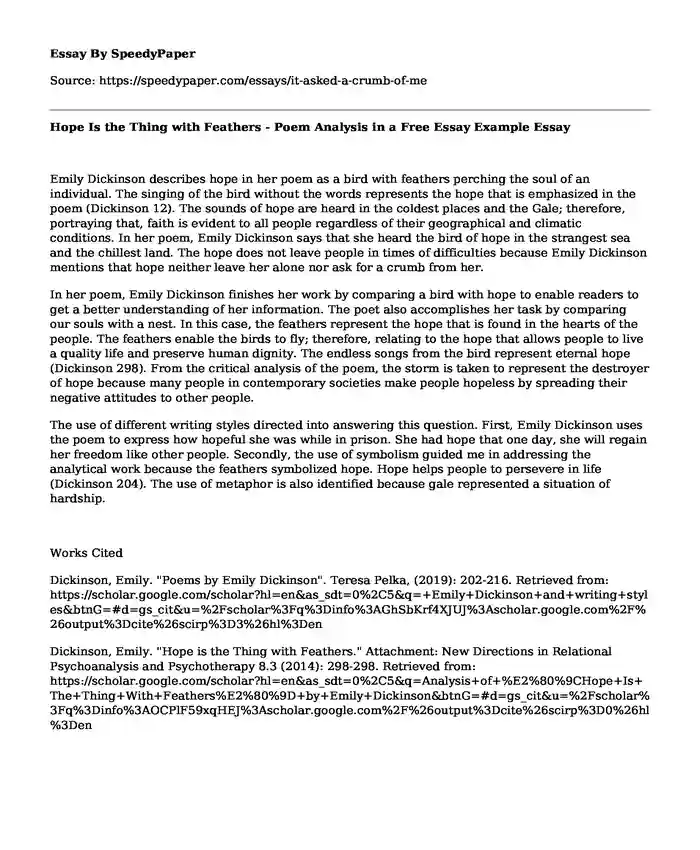
| Type of paper: | Essay |
| Categories: | Emily Dickinson |
| Pages: | 2 |
| Wordcount: | 437 words |
Emily Dickinson describes hope in her poem as a bird with feathers perching the soul of an individual. The singing of the bird without the words represents the hope that is emphasized in the poem (Dickinson 12). The sounds of hope are heard in the coldest places and the Gale; therefore, portraying that, faith is evident to all people regardless of their geographical and climatic conditions. In her poem, Emily Dickinson says that she heard the bird of hope in the strangest sea and the chillest land. The hope does not leave people in times of difficulties because Emily Dickinson mentions that hope neither leave her alone nor ask for a crumb from her.
In her poem, Emily Dickinson finishes her work by comparing a bird with hope to enable readers to get a better understanding of her information. The poet also accomplishes her task by comparing our souls with a nest. In this case, the feathers represent the hope that is found in the hearts of the people. The feathers enable the birds to fly; therefore, relating to the hope that allows people to live a quality life and preserve human dignity. The endless songs from the bird represent eternal hope (Dickinson 298). From the critical analysis of the poem, the storm is taken to represent the destroyer of hope because many people in contemporary societies make people hopeless by spreading their negative attitudes to other people.
The use of different writing styles directed into answering this question. First, Emily Dickinson uses the poem to express how hopeful she was while in prison. She had hope that one day, she will regain her freedom like other people. Secondly, the use of symbolism guided me in addressing the analytical work because the feathers symbolized hope. Hope helps people to persevere in life (Dickinson 204). The use of metaphor is also identified because gale represented a situation of hardship.
Works Cited
Dickinson, Emily. "Poems by Emily Dickinson". Teresa Pelka, (2019): 202-216. Retrieved from: https://scholar.google.com/scholar?hl=en&as_sdt=0%2C5&q=+Emily+Dickinson+and+writing+styles&btnG=#d=gs_cit&u=%2Fscholar%3Fq%3Dinfo%3AGhSbKrf4XJUJ%3Ascholar.google.com%2F%26output%3Dcite%26scirp%3D3%26hl%3Den
Dickinson, Emily. "Hope is the Thing with Feathers." Attachment: New Directions in Relational Psychoanalysis and Psychotherapy 8.3 (2014): 298-298. Retrieved from: https://scholar.google.com/scholar?hl=en&as_sdt=0%2C5&q=Analysis+of+%E2%80%9CHope+Is+The+Thing+With+Feathers%E2%80%9D+by+Emily+Dickinson&btnG=#d=gs_cit&u=%2Fscholar%3Fq%3Dinfo%3AOCPlF59xqHEJ%3Ascholar.google.com%2F%26output%3Dcite%26scirp%3D0%26hl%3Den
Cite this page
Hope Is the Thing with Feathers - Poem Analysis in a Free Essay Example. (2022, Feb 21). Retrieved from https://speedypaper.com/essays/it-asked-a-crumb-of-me
Request Removal
If you are the original author of this essay and no longer wish to have it published on the SpeedyPaper website, please click below to request its removal:
- Time Management Essay Sample
- Art Essay Sample Describing the Carybe Painting
- Lululemon Athletica Inc. - Marketing Essay Example
- Essay Example on the ACM Code of Conduct on Information Technology
- Essay Example on Three Major Elements of US History
- Analysis Essay Example on The Man Who Thought Himself a Woman
- Essay Sample on American Culture: Media and Social Problems
Popular categories




